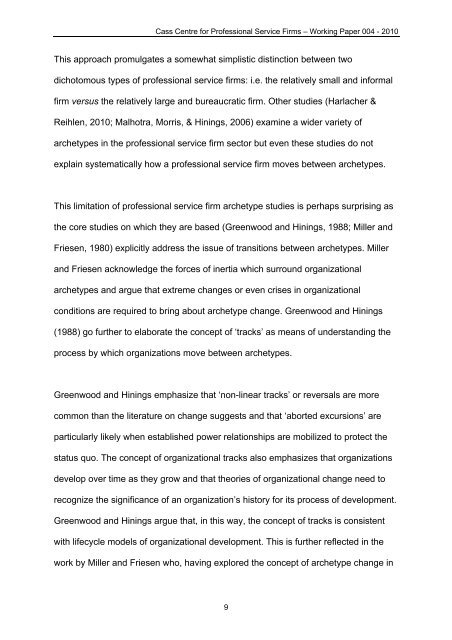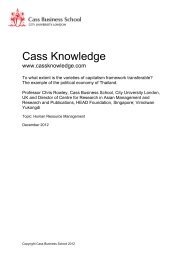A multi-stage model of governance in ... - Cass Knowledge
A multi-stage model of governance in ... - Cass Knowledge
A multi-stage model of governance in ... - Cass Knowledge
You also want an ePaper? Increase the reach of your titles
YUMPU automatically turns print PDFs into web optimized ePapers that Google loves.
<strong>Cass</strong> Centre for Pr<strong>of</strong>essional Service Firms – Work<strong>in</strong>g Paper 004 - 2010<br />
This approach promulgates a somewhat simplistic dist<strong>in</strong>ction between two<br />
dichotomous types <strong>of</strong> pr<strong>of</strong>essional service firms: i.e. the relatively small and <strong>in</strong>formal<br />
firm versus the relatively large and bureaucratic firm. Other studies (Harlacher &<br />
Reihlen, 2010; Malhotra, Morris, & H<strong>in</strong><strong>in</strong>gs, 2006) exam<strong>in</strong>e a wider variety <strong>of</strong><br />
archetypes <strong>in</strong> the pr<strong>of</strong>essional service firm sector but even these studies do not<br />
expla<strong>in</strong> systematically how a pr<strong>of</strong>essional service firm moves between archetypes.<br />
This limitation <strong>of</strong> pr<strong>of</strong>essional service firm archetype studies is perhaps surpris<strong>in</strong>g as<br />
the core studies on which they are based (Greenwood and H<strong>in</strong><strong>in</strong>gs, 1988; Miller and<br />
Friesen, 1980) explicitly address the issue <strong>of</strong> transitions between archetypes. Miller<br />
and Friesen acknowledge the forces <strong>of</strong> <strong>in</strong>ertia which surround organizational<br />
archetypes and argue that extreme changes or even crises <strong>in</strong> organizational<br />
conditions are required to br<strong>in</strong>g about archetype change. Greenwood and H<strong>in</strong><strong>in</strong>gs<br />
(1988) go further to elaborate the concept <strong>of</strong> ‘tracks’ as means <strong>of</strong> understand<strong>in</strong>g the<br />
process by which organizations move between archetypes.<br />
Greenwood and H<strong>in</strong><strong>in</strong>gs emphasize that ‘non-l<strong>in</strong>ear tracks’ or reversals are more<br />
common than the literature on change suggests and that ‘aborted excursions’ are<br />
particularly likely when established power relationships are mobilized to protect the<br />
status quo. The concept <strong>of</strong> organizational tracks also emphasizes that organizations<br />
develop over time as they grow and that theories <strong>of</strong> organizational change need to<br />
recognize the significance <strong>of</strong> an organization’s history for its process <strong>of</strong> development.<br />
Greenwood and H<strong>in</strong><strong>in</strong>gs argue that, <strong>in</strong> this way, the concept <strong>of</strong> tracks is consistent<br />
with lifecycle <strong>model</strong>s <strong>of</strong> organizational development. This is further reflected <strong>in</strong> the<br />
work by Miller and Friesen who, hav<strong>in</strong>g explored the concept <strong>of</strong> archetype change <strong>in</strong><br />
9






